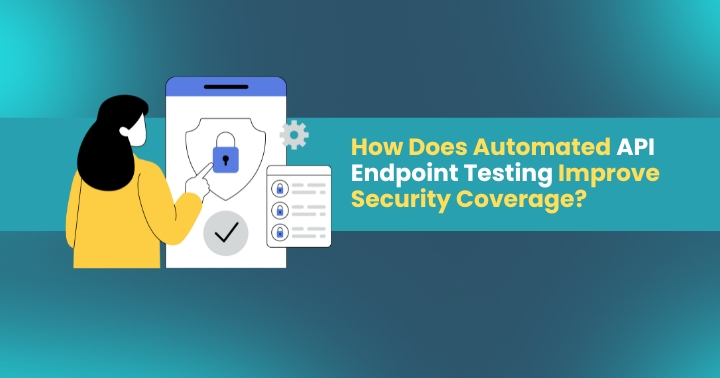Table of Contents
- What is Automated API Endpoint Security Testing?
- What automated API endpoint testing covers that manual testing misses
- How automated testing scales security coverage across enterprise APIs
- Why automated API testing reduces security blind spots
- When automated testing improves vulnerability detection rates
- Which API security risks does automated testing catch faster
- How to measure security coverage improvements with automation
- FAQS
API security is a critical concern for enterprises today. In fact, data breaches related to APIs can cost businesses an average of $4.88 million per breach, as reported by the IBM/Ponemon Institute's 2024 "Cost of a Data Breach" report. This stark figure underscores the growing need for robust security practices that prevent API vulnerabilities before they are exploited.
Traditional manual testing covers less than 20% of API endpoints, leaving organizations exposed to potential threats. Automated API testing, on the other hand, can drastically improve security coverage while reducing the time required to identify vulnerabilities. In this blog, we’ll dive into how automated API testing can help improve your security posture, detect vulnerabilities faster, and ensure comprehensive coverage across all your API endpoints.
What is Automated API Endpoint Security Testing?
Automated API endpoint security testing is a process where specialized software tools automatically test and verify the security of your APIs (Application Programming Interfaces) to ensure they’re safe from vulnerabilities. Instead of relying on manual testing by a developer or security expert, automated testing uses scripts and tools to scan APIs for potential weaknesses that could be exploited by attackers.
In simple terms, it’s like setting up an automated system to continuously check if the doors and windows of your digital house (APIs) are locked and secure, without needing someone to do it manually every time.
These tools can:
- Test thousands of endpoints (points where the API communicates with other systems or users) much faster than a person could do by hand.
- Simulate attacks to see if any part of the API is vulnerable.
- Run checks on every change in your code, making sure that no new vulnerabilities are introduced.
Automated API testing is essential because it helps find problems before they affect your users, saving time and protecting your data. By using this testing, companies can quickly identify weak spots in their API security and fix them before attackers can take advantage.
Read- API Endpoint Guide
What Automated API Endpoint Testing Covers That Manual Testing Misses
Manual testing is valuable, but it can only reach so far due to time and resource constraints. Automated API testing goes further, covering areas that manual testing often misses:
- Edge cases and parameter combinations: Automated testing can check over 10,000 different parameter combinations versus just 50-100 that manual testers typically cover. This allows for deeper exploration into how the API responds under extreme or unexpected conditions.
- Authentication bypass scenarios: Automated testing tools simulate various user scenarios to identify authentication flaws that might be overlooked in manual tests.
- Rate-limiting vulnerabilities: Automated testing tools can quickly identify rate-limiting flaws that might otherwise be ignored in manual testing due to time constraints.
- Data exposure through error messages: Automated tests are thorough, checking for the possibility of data exposure through unexpected error messages that can leak sensitive information.
By leveraging APIsec, you can ensure your API is covered from every angle, detecting flaws in places manual testing often misses.
How Automated Testing Scales Security Coverage Across Enterprise APIs
When it comes to enterprise-level APIs, manual testing simply doesn’t scale. Here’s how automated testing addresses this challenge:
- Continuous testing integration: Automated testing can be integrated into your CI/CD pipeline, ensuring that APIs are continuously tested every time code changes are deployed.
Learn more about How to Secure an API: Best Practices for Ongoing Security. - Multi-environment coverage: Unlike manual testing, which is typically siloed to one environment, automated tools can test APIs across development, staging, and production environments. This ensures consistent security checks at every stage.
- Parallel endpoint analysis: Automated tools can test multiple endpoints simultaneously, allowing enterprises to test hundreds or thousands of endpoints in parallel. This scale simply isn’t possible with manual testing.
Why coverage metrics matter: While manual testing may provide a small snapshot of security risks, coverage metrics from automated testing show the full security picture, making it clear how much of your API is being covered and what gaps still need attention.
Why Automated API Testing Reduces Security Blind Spots
Manual testing is prone to inconsistency and errors, creating security blind spots. Automated testing can eliminate these gaps by:
- Consistent testing methodology: Automated tools apply the same testing criteria every time, ensuring consistency and eliminating any human error or oversight.
- Hidden endpoint discovery: Automated testing scans for hidden or forgotten endpoints that could be a major security risk.
- Third-party API integration testing: It’s easy to overlook third-party integrations in manual testing, but automated tools can systematically test API interactions with external services, ensuring those connections don’t introduce vulnerabilities.
Read - For pricing and cost of an Api testing
When Automated Testing Improves Vulnerability Detection Rates
One of the biggest advantages of automated testing is its speed and efficiency in detecting vulnerabilities:
- Pre-production integration: Automated testing can be integrated early in the development cycle, allowing vulnerabilities to be caught before deployment.
APIsec ensures that security is part of your development from day one. - Regression testing scenarios: Automated tests continuously check for regressions, ensuring new code updates don’t inadvertently introduce vulnerabilities from the past.
- Compliance audit preparation: Automated testing tools generate reports that help prepare for compliance audits, ensuring that your APIs meet security standards and reducing the risk of non-compliance.
- Incident response validation: Automated tests provide valuable insights into how the system might behave during a real attack, helping refine your incident response strategies.
Which API Security Risks Does Automated Testing Catch Faster
Automated testing tools are particularly effective at identifying certain, high-priority security risks quickly:
- Business logic flaws: Automated tools quickly identify issues in business logic that could result in unauthorized actions or unintended data exposure, such as BOLA (Broken Object Level Authorization).
Learn more about BOLA testing. - Authorization vulnerabilities: Automated testing quickly identifies authorization flaws, ensuring that only authorized users can access sensitive resources.
- Input validation bypasses: Automated testing identifies weaknesses in input validation, which can be exploited by attackers to inject malicious data.
- Data leakage patterns: Tools can detect data leakage through error messages or unauthorized data access.
How to Measure Security Coverage Improvements with Automation
Measuring the effectiveness of automated testing is crucial to demonstrating its ROI. Here’s how automation improves security coverage:
- Coverage percentage metrics: Automated tools provide comprehensive coverage metrics, allowing you to track the percentage of your API that’s been tested for vulnerabilities.
- Time-to-detection improvements: Automated testing reduces time-to-detection, catching vulnerabilities earlier in the lifecycle than manual tests.
- False positive reduction: Automated tools help reduce false positives, ensuring that your security team can focus on real threats instead of chasing down non-issues.
- Cost per vulnerability found: By automating the testing process, the cost per vulnerability detected is significantly lower, making it a cost-effective solution for scaling security across large enterprises.
Conclusion
Automated API endpoint testing delivers significant improvements in security coverage by reducing testing time and expanding testing scope. With its ability to cover thousands of endpoints and detect vulnerabilities before deployment, automated testing enables enterprises to stay ahead of potential threats.
If you want to expand your security coverage and ensure your APIs are protected, start exploring APIsec’s automated testing solutions today.
Key Takeaways
- Automated testing increases coverage by 200-400%, testing thousands of combinations and edge cases that manual testing can’t reach.
- Automated testing integrates easily into CI/CD pipelines, allowing for continuous security testing.
- Automation reduces blind spots by providing consistent testing methodologies and eliminating human error.
- Detection rates improve with automated testing, catching vulnerabilities early and validating incident response.
- Automated tools catch API security risks faster, including business logic flaws, authorization vulnerabilities, and data leakage.
- Cost-effective security: Automated testing reduces the cost per vulnerability found, enabling scalable security solutions.
FAQs
How much more API security coverage does automation provide compared to manual testing?
Automated testing increases security coverage by 200-400%, testing thousands of parameter combinations and edge cases that manual testing cannot feasibly cover.
Can automated API testing replace manual security assessments entirely?
Automated testing significantly expands coverage but works best alongside manual testing for complex business logic validation and novel attack vector discovery.
What types of API vulnerabilities does automated testing miss?
Automated tools may miss context-specific business logic flaws, social engineering vectors, and highly customized attack scenarios that require human creativity and domain expertise.
How quickly can automated API testing expand security coverage?
Most automated API security tools can analyze and test hundreds of endpoints within hours, compared to weeks or months for manual testing.
Does automated API testing work with microservices architectures?
Yes, automated testing excels in microservices environments by continuously testing service-to-service communications and API dependencies that would be impractical to test manually at scale.
.webp)

.webp)

